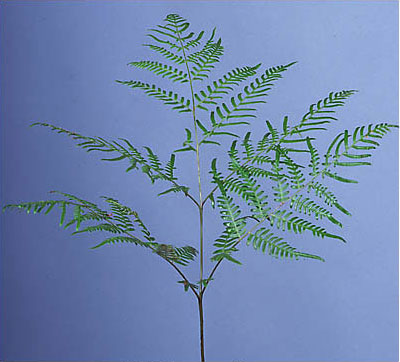Bracken Fern
Pteridium aquilinum
Family: Dennstaedtiaceae
Natural History
 Frond of bracken fern
Frond of bracken fern
Photo credit: Larry Korhnak, University of Florida
Bracken fern is a perennial fern occurring globally in dry to wet forests, meadows, clearings, sandy soils, roadsides, lake-shores, bogs, and burned areas. The underground stems or rhizomes are deep, giving it the ability to survive intense fires.
There is only one species that grows in the southeast, but different varieties occur outside this area.
Southern bracken is found in most of the eastern United States between Florida and Oklahoma in the south, to Missouri, Illinois, and Massachusetts in the north. Eastern bracken is found between Oklahoma and North Carolina in the south, to Minnesota, Quebec, and Newfoundland in the north.
Several groups of people have used the bracken fern as a food source. Some have boiled and eaten the fiddleheads and virtually all Native Americans used the rhizomes as food. They roasted the dried rhizomes in an open fire, broke the rhizomes into pieces and ate them or steamed the rhizomes in pits or made a type of bread with them. The bracken fern also provides minor amounts of cover for wildlife.
Bracken fern leaves are known to be poisonous to livestock when eaten in large amounts. The toxic ingredient is an enzyme that destroys the animals' thiamin reserves.
Bracken fern has multiple branching stems and triangular-shaped fronds with many leaflet-like segments. This fern does not grow in clusters as many ferns do. It produces tiny brown spore clusters July through September.
